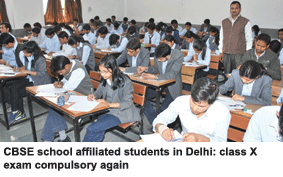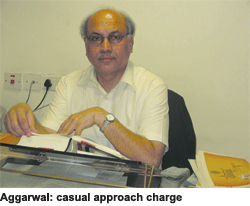 In a second major reversal decision after rollback of Delhi University’s four-year undergraduate programme in 2014, the BJP/NDA government at the Centre has compelled the Delhi-based Central Board of Secondary Education (CBSE), the country’s largest national school-leaving examinations board (18,417 affiliated government and private schools), to restore class X board exams. In 2010, this high school examination was made optional by the then Congress-led UPA government which substituted it with the continuous and comprehensive evaluation (CCE) system. On December 20, the board of governors of CBSE unanimously approved reintroduction of a compulsory class X board exam for all affiliated schools from March 2018.
In a second major reversal decision after rollback of Delhi University’s four-year undergraduate programme in 2014, the BJP/NDA government at the Centre has compelled the Delhi-based Central Board of Secondary Education (CBSE), the country’s largest national school-leaving examinations board (18,417 affiliated government and private schools), to restore class X board exams. In 2010, this high school examination was made optional by the then Congress-led UPA government which substituted it with the continuous and comprehensive evaluation (CCE) system. On December 20, the board of governors of CBSE unanimously approved reintroduction of a compulsory class X board exam for all affiliated schools from March 2018.
This decision of the CBSE — an ‘autonomous’ board established by the Central government in 1962 under the jurisdiction of the Union human resource development (HRD) ministry — was a foregone conclusion following alarming reports of plunging learning outcomes in India’s 37,000 colleges and 800 universities. Under s.16 of the landmark Right of Children to Free & Compulsory Education (RTE) Act, 2009, no child can be detained for any reason until class VIII. This provision was made in the Act to relieve children from the stress of writing examinations in primary and upper primary education.
In 2010, the HRD ministry under the Congress party’s liberal legal eagle Kapil Sibal issued a circular making the class X exam optional for all CBSE affiliated secondaries. But with the fear of detention and examinations removed until class XII, and the country’s 7 million under-trained and haphazardly certified primary-secondary teachers unable to properly implement CCE, most students performed badly in the testing class XII examinations (see p.66).
Inevitably, this decision of the BJP/NDA government has angered Left-liberal academics who dominate the academy. According to Dr. Krishna Kumar, former director of NCERT (National Council of Educational Research & Training) and professor of education at Delhi University, “the public examination, taken by a ‘board’, has become an integral part of modern India’s culture, permeating every aspect of life, from parenting to scheduling of elections”. “Over the last 100 years, our exam system has withstood numerous attempts to reform it. No panel — since the Sadler Commission set up in 1919 — has failed to criticise the exam system and hold it responsible for defeating the State’s efforts to improve the quality of education. A paradox underlies such criticisms. While the exam system is disliked, institutions that conduct their exams with rigour are believed to have high standards,” he wrote in the Hindustan Times (December 20).
This viewpoint is seconded by Prof. M. M. Pant, a former pro vice chancellor of the Indira Gandhi National Open University (IGNOU). “We have gradually reduced whatever little higher order thinking skills we once had, thanks to the public examination system,” he says.
However, primary-secondary teachers who are obliged to cope with the consequences of haphazard, under-researched and politically correct liberal legislation such as the RTE Act and CCE, have a more realistic assessment of ground conditions. “As an educationist, I still believe CCE is a better option to the make-or-break class X exam which causes great stress. But implementation of CCE without proper teacher training has resulted in competition among schools to award high CGPAs (Cumulative Grade Points Average) to their own students under the self-assessment scheme. The prime objective of CCE — to develop thinking skills of students — has not been attained. Therefore restoring the class X exam is the lesser evil,” says Ragini Kaul, principal of the G.D. Goenka School, Rohini.
The sad truth is that the issue of raising quality standards in school education has been ignored by successive governments at the Centre and in the states for so long, that band-aid solutions such as restoration of the class X exam is the better choice.
Autar Nehru (Delhi)
Mere Rhetoric
 The delhi state government is on a teacher recruitment spree and has set itself the target to fill 26,031 vacancies in 1,977 municipal and state government schools of Delhi before the new academic year begins in June.
The delhi state government is on a teacher recruitment spree and has set itself the target to fill 26,031 vacancies in 1,977 municipal and state government schools of Delhi before the new academic year begins in June.
This decision, announced by deputy chief and education minister Manish Sisodia on December 20, has been prompted by an October 17 notice from the Delhi high court to the state and municipal governments of Delhi. It directed them to respond to a contempt petition filed by Delhi-based NGO Social Jurist alleging that the state government and Delhi Municipal Corporation have failed to follow a 2001 Delhi high court order in Social Jurist vs. Govt. of NCT of Delhi & Ors which directed them to work towards a “zero vacancy” policy at the commencement of each academic year.
In its contempt petition, Social Jurist alleged that the existence of 26,031 teachers vacancies in Delhi’s 1,977 municipal and state government schools constituted “wilful disobedience” by the Delhi state and municipal governments. “This 50 percent vacancy is startling. It is too high a figure... The system is crumbling,” said Justice Manmohan Singh presiding over a single judge bench which heard the petition.
“Announcing measures such as signing up with institutes like IITs, IIMs for teacher training or even sending selected teachers abroad, is mere eyewash. The government needs to create favourable conditions in government schools to attract good teachers. Also, how will appointing retired government school teachers, who have contributed to the decline of government schools help? These grand announcements without follow-up action are a reflection of the government’s casual approach to dealing with education which should be its top priority,” says Ashok Aggarwal, a Delhi-based lawyer activist, and founder-president of Social Jurist.
Educationists and academics in Delhi are unanimous that inadequacy of teacher training institutes is a serious national problem and challenge. There are a mere 1,178 government-run teacher training institutes and 12,689 self-financed affiliated colleges including 6,076 B.Ed colleges countrywide. They allege that the apex-level National Council for Teacher Education (NCTE, estb.1995) has been recklessly licensing teacher training colleges without due diligence, resulting in inadequately trained teachers being certified by them. The pass percentage in the government’s Central Teacher Eligibility Test ranges between 1-14 percent.
“Lack of proper teacher training institutes is one of the biggest challenges of Indian education. There is an urgent need to change the pre and in-service training curriculum. High-quality teacher training which equips teachers with a deep sense of purpose and values is needed. But all of this requires a willingness to bring about systemic change,” says Shaheen Mistry, promoter-director of Akanksha (estb.1991), a Mumbai-based education NGO and chief executive officer of The Teach for India fellowship programme since 2008.
Unfortunately, there’s very little awareness within the Central government and HRD ministry — and even less in the states — that quality education has a stiff price tag. Despite the Kothari Commission having recommended provision of 6 percent of GDP (Centre plus states) for education in 1966 — a recommendation unequivocally endorsed by the Committee for Evolution of the New Policy on Education 2016 chaired by former Union cabinet secretary T.S.R. Subramanian — according to a mint-new report, Public Financing of School Education in India: A Fact Sheet jointly published by the Delhi-based Centre for Budget & Governance Accountability and Child Rights & You, “in the last four years (ending 2015-16) there is a decline in the overall quantum of budgetary spending/allocation for school education as a proportion of the country’s GDP” with the allocation a mere 2.68 percent in 2015-16.
Nor is the Centre likely to raise its pathetic 0.48 percent of GDP allocation in the Union budget scheduled to be presented on February 1.
Swati Roy (Delhi)